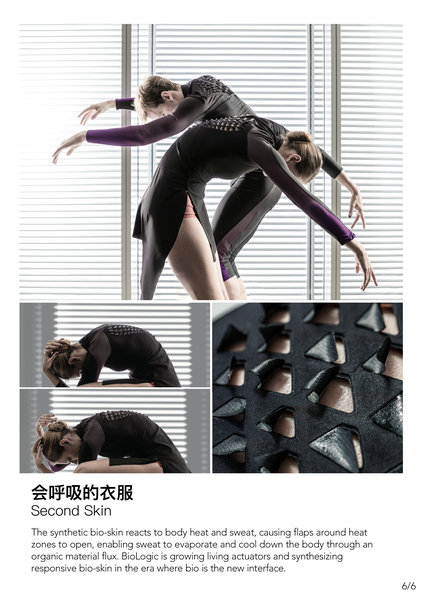Homing Fantasy
 |
|
Finalists of the Design Intelligence Award 2016 include "breathing" clothes[Photo provided to China Daily] |
While Dankovich's "book" impressed the judges, there were other entries that attracted attention. For instance, Wang Wen, a postdoctoral fellow from Massachusetts Institute of Technology, showed her team's entry called "second skin".
It is described as clothes that are able to breathe. They can spontaneously expand and shrink in accordance with changes in humidity and temperature on human skin. The project was among the 21 finalists of the award.
"Second skin" is still in development, but several sports brands in the United States have already shown interest in it, she says.
Expressing optimism about its potential, Wang says: "This is only a demo that is being used in sports facilities, but we want to touch more people's lives, like firefighters, soldiers and pilots."
Wang, who was born in Zhejiang, also believes the mass manufacturing capacity of clothes in her home province can help turn her dream project into reality.
Touching on interdisciplinary cooperation, CAA professor Song Jianming, head of a professional judging panel, says this is one of the things encouraged in the competition, and that market potential is also a crucial criteria when it comes to picking winners. He also says intellectual property rights are a priority.
The organizers received more than 2,000 design blueprints from around the world for the award. An exhibition at CAA's Folk Crafts Museum in Hangzhou is displaying some 200 works.
Speaking of other criteria that were taken into consideration while picking the winners, another judge, Lu Xiaobo, principal of the Academy of Arts & Design, Tsinghua University, says: "No matter what the size is, a good design should solve problems and improve people's lives through new technology.
"A good idea is driven by observation in life. A designer shouldn't only be immersed in self-expression and ignore functionality," he adds.
Another judge Zhao Jian says while not every design could turn the world upside down, even enriching people's lives is a worthwhile effort. Japanese designer Ono Naoki's work is a good example of this. His "poster lamp" failed to make the first-round appraisal for the final selection, but was praised by many at the event.






















